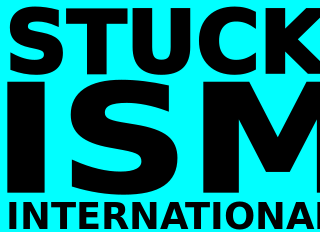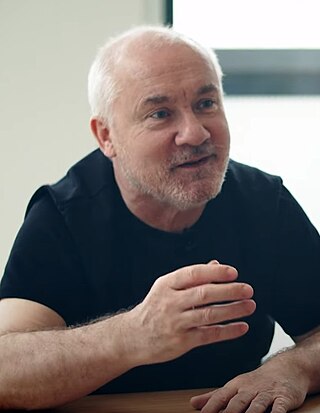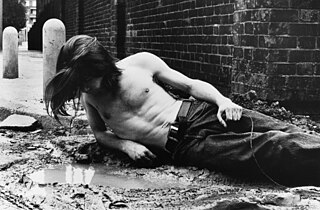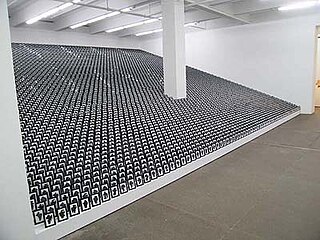Related Research Articles

Stuckism is an international art movement founded in 1999 by Billy Childish and Charles Thomson to promote figurative painting as opposed to conceptual art. By May 2017 the initial group of 13 British artists had expanded to 236 groups in 52 countries.

The Young British Artists, or YBAs—also referred to as Brit artists and Britart—is a loose group of visual artists who first began to exhibit together in London in 1988. Many of the YBA artists graduated from the BA Fine Art course at Goldsmiths, in the late 1980s, whereas some from the group had trained at Royal College of Art.

Tracey Karima Emin is an English artist known for autobiographical and confessional artwork. She produces work in a variety of media including drawing, painting, sculpture, film, photography, neon text and sewn appliqué. Once the "enfant terrible" of the Young British Artists in the 1980s, Tracey Emin is now a Royal Academician.

Damien Steven Hirst is an English artist and art collector. He is one of the Young British Artists (YBAs) who dominated the art scene in the UK during the 1990s. He is reportedly the United Kingdom's richest living artist, with his wealth estimated at US$384 million in the 2020 Sunday Times Rich List. During the 1990s his career was closely linked with the collector Charles Saatchi, but increasing frictions came to a head in 2003 and the relationship ended.
Charles Saatchi is an Iraqi-British businessman and the co-founder, with his brother Maurice, of advertising agency Saatchi & Saatchi. The brothers led the business – the world's largest advertising agency in the 1980s – until they were forced out in 1995. In the same year, the brothers formed a new agency called M&C Saatchi.

The Saatchi Gallery is a London gallery for contemporary art and an independent charity opened by Charles Saatchi in 1985. Exhibitions which drew upon the collection of Charles Saatchi, starting with US artists and minimalism, moving to the Damien Hirst-led Young British Artists, followed by shows purely of painting, led to Saatchi Gallery becoming a recognised authority in contemporary art globally. It has occupied different premises, first in North London, then the South Bank by the River Thames, and finally in Chelsea, Duke of York's HQ, its current location. In 2019 Saatchi Gallery became a registered charity and began a new chapter in its history. Recent exhibitions include the major solo exhibition of the artist JR, JR: Chronicles, and London Grads Now in September 2019 lending the gallery spaces to graduates from leading fine art schools who experienced the cancellation of physical degree shows due to the pandemic.
Momart is a British company specialising in the storage, transportation, and installation of works of art. A major proportion of their business is maintaining often delicate artworks in a secure, climate-controlled environment. The company maintains specialist warehouse facilities adapted for this task. Momart's clients include the Royal Academy of Arts, the Victoria and Albert Museum, the National Gallery, Tate Modern, Tate Britain and Buckingham Palace. The company received considerable media attention in 2004 when a fire spread to one of their warehouses from an adjacent unit, destroying the works in it, including works by Young British Artists such as Tracey Emin and Damien Hirst, including Emin's 1995 piece Everyone I Have Ever Slept With 1963–1995. On 5 March 2008 Momart was taken over by Falkland Islands Holdings for £10.3 million, of which £4.6 million was in cash, £2.5 million was in shares and £3.2 million was deferred consideration.
Sarah Lucas is an English artist. She is part of the generation of Young British Artists who emerged in 1988. Her works frequently employ visual puns and bawdy humour by incorporating photography, sculpture, collage and found objects.

Matthew "Mat" Collishaw Hon. FRPS is a contemporary British artist based in London.

Charles Thomson is an English artist, poet and photographer. In the early 1980s he was a member of The Medway Poets. In 1999 he named and co-founded the Stuckists art movement with Billy Childish. He has curated Stuckist shows, organised demonstrations against the Turner Prize, run an art gallery, stood for parliament and reported Charles Saatchi to the OFT. He is frequently quoted in the media as an opponent of conceptual art. He was briefly married to artist Stella Vine.
Carl Freedman is the founder of Carl Freedman Gallery. He previously worked as a writer and a curator.
Abigail Lane is an English artist who works in photography, wax casting, printing and sound. Lane was one of the exhibitors in the 1988 Damien Hirst-led Freeze exhibition—a mixed show of art which was significant in the development of the later-to-be YBA scene of art.
Adrian Searle is the chief art critic of The Guardian newspaper in Britain, and has been writing for the paper since 1996. Previously he was a painter.
Louisa Buck is a British art critic and contemporary art correspondent for The Art Newspaper. She is also an author or co-author of books on contemporary art market.

Stuckist demonstrations since 2000 have been a key part of the Stuckist art group's activities and have succeeded in giving them a high-profile both in Britain and abroad. Their primary agenda is the promotion of figurative painting and opposition to conceptual art.

Neo-conceptual art describes art practices in the 1980s and particularly 1990s to date that derive from the conceptual art movement of the 1960s and 1970s. These subsequent initiatives have included the Moscow Conceptualists, United States neo-conceptualists such as Sherrie Levine and the Young British Artists, notably Damien Hirst and Tracey Emin in the United Kingdom, where there is also a Stuckism counter-movement and criticism from the 1970s conceptual art group Art and Language.

Sir Nicholas Serota Makes an Acquisitions Decision is one of the paintings that was made as a part of the Stuckism art movement, and is recognized as a "signature piece" for the movement, It was painted by the Stuckism co-founder Charles Thomson in 2000, and has been exhibited in a number of shows since, as well as being featured on placards during Stuckist demonstrations against the Turner Prize.

The Stuckism International Gallery was the gallery of the Stuckist art movement. It was open from 2002 to 2005 in Shoreditch, and was run by Charles Thomson, the co-founder of Stuckism. It was launched by a procession carrying a coffin marked "The death of conceptual art" to the neighbouring White Cube gallery.

Everyone I Have Ever Slept With 1963–1995 (1995), also known as The Tent, was an artwork by Tracey Emin. The work was a tent with the appliquéd names of, literally, everyone she had ever slept with. It achieved iconic status and was owned by Charles Saatchi. Since its destruction in the 2004 Momart London warehouse fire, Emin has refused to recreate the piece.
Gregor Muir is Director of Collection, International Art, at Tate, having previously been the Executive Director of the Institute of Contemporary Arts in London from 2011 until 2016. He was the director of Hauser & Wirth, London, at 196a Piccadilly, from 2004 - 2011. He is also the author of a 2009 memoir in which he recounts his direct experience of the YBA art scene in 1990s London.
References
- 1 2 3 Buck, Louisa (2000). Moving Targets 2: A User's Guide to British Art Now. Tate Gallery Publishing. ISBN 1-85437-316-1
- ↑ "Media Guy" by Merlin Carpenter Retrieved 28 March 2006
- 1 2 "Do You Wanna Be in My Gang" by Liz Ellis Retrieved 28 March 2006
- ↑ "The Decrepitude of the Critic", point 5, Stuckist manifesto, 2000 Retrieved 2 April 2006
- ↑ "And, on this page, Rosanna Greenstreet asked some movers and shakers", The Independent, December 24, 1995 Retrieved from findarticles.com 2 April 2006
- ↑ “A Dying Wish”, Brian Sewell, ‘’The Evening Standard’’, 29 July 2003. Retrieved 2 April 2006
- ↑ Art or Arse, lyrics. stuckism.com Retrieved 28 March 2006
- ↑ "Turner Prize History", Tate website Archived 26 September 2006 at the Wayback Machine Retrieved 28 March 2006
- ↑ Sarah Kent, ‘’Time Out’’, 1983 Retrieved 2 April 2006 from garywragg.co.uk
- ↑ Time Out, London, Lisson Gallery, London, April 3, 1996 Retrieved 28 March 2006 from bu.edu
- ↑ "What the Critics Say – Jim Shaw at the ICA" Archived 25 October 2006 at the Wayback Machine , newsletter 2, artrumour.com, 23 October 2000. Retrieved 28 March 2006